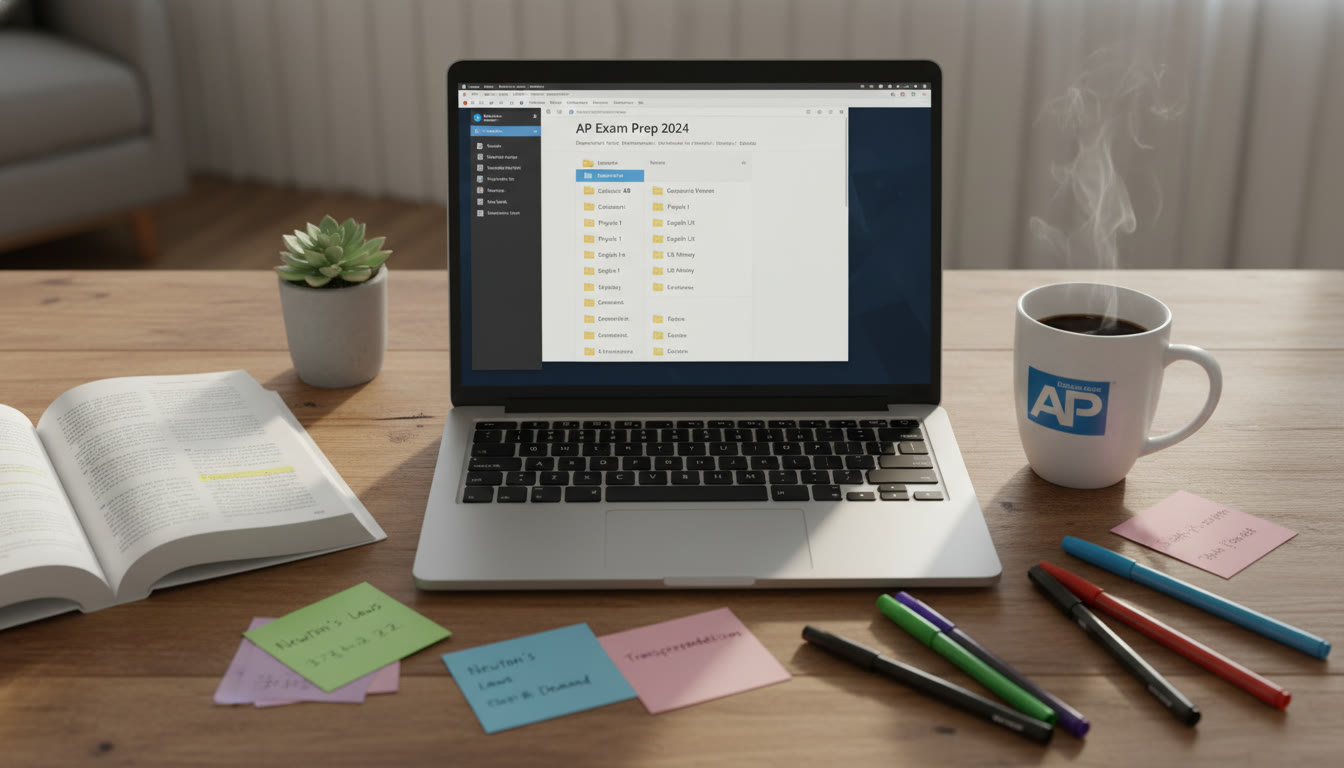What Is an “Evidence Sprint” Week — and Why It Works
Picture this: you’ve read three chapters, taken two practice tests, and watched a stack of review videos — but when exam day comes, your answers are patchy, and you can’t find the examples or quotations you need. That’s the common gap between being busy and being effective. An “Evidence Sprint” week is a focused, short-duration workflow where you intentionally capture, name, and file every piece of evidence — facts, quotes, formulas, annotated diagrams, and quick sample answers — so they become instantly retrievable when you need them during practice or on the AP exam.
This approach borrows from product development sprints and academic best practices: keep the time-box short (typically 5–7 days), aim for clear, concrete outputs, and iterate. The result is a living, searchable study archive that reduces stress, speeds revision, and boosts your confidence.
Who should run an Evidence Sprint?
- Any AP student in the middle or final trimester of prep who needs higher recall and faster application.
- Parents helping structure study time for a motivated teen.
- Teachers coordinating a class-wide review week before a midterm or the AP exam.

The Three Pillars: Capture, Name, File
Every Evidence Sprint centers on three low-friction practices. Master these, and your study materials will feel less like scattered notes and more like a dependable reference system.
1. Capture — Collect with Intent
Capture everything useful, but capture with criteria. Don’t copy entire textbook pages — extract the kernel. Ask: “Is this a fact, an example, an argument, a model, or a question I can test myself with?”
- Facts and formulas: exact, short, and verifiable.
- Examples and evidence: textbook cases, historical events, experimental results, or sample problems.
- Key phrasing: concise sentence templates useful for short-answer or long-essay prompts.
- Common pitfalls: typical mistakes and how to avoid them.
Tools you can use: index cards, a single notes app, voice memos for quick capture, or a simple spreadsheet. Whatever you start with, be consistent.
2. Name — Make It Findable
Good names save time. A quick, consistent naming convention turns chaotic notes into a retrievable database.
Use this simple pattern as a starting point: Course_Topic_Type_ShortID. For example:
- APUSH_Reconstruction_Example_BR1
- APBio_Glycolysis_Formula_F1
- APLang_RhetoricalDevice_Def_Rhet1
Why this helps: when you’re practicing FRQs or DBQs, you can search by topic or type and quickly pull up a relevant quotation, fact, or diagram.
3. File — Create a System You Will Use
Filing is both physical and digital. Choose a primary home for everything — a drawer of index cards, a dedicated notebook, or a digital folder structure. The most important rule is: store once, retrieve often.
Suggested folder structure (digital or physical):
- Course (AP Calculus AB)
- Unit (Integrals)
- Type (Formulas, Example Problems, Common Mistakes)
Make retrieval easy: add tags or highlight color codes for quick scanning. The time you spend organizing is paid back exponentially when you study under pressure.
How to Run a 7-Day Evidence Sprint: Day-by-Day Plan
Below is an actionable sprint plan you can adapt. Each day has a clear output — small wins that compound into a powerful review resource.
| Day | Primary Focus | Concrete Output |
|---|---|---|
| Day 1 | Scope and capture key learning targets | Master list of topics and 15–20 captured items (facts, formulas, sample prompts) |
| Day 2 | Deep-dive on core concepts | 10 annotated examples and 5 problem-solution pairs |
| Day 3 | Collect evidence for essay/FRQ prompts | 6–8 quotable lines, thesis frames, and evidence cards |
| Day 4 | Practice retrieval under time | Timed mini-tests + feedback notes |
| Day 5 | Organize and name every captured item | Consistent file names/tags and folder structure |
| Day 6 | Consolidate and convert to study tools | Flashcards, cheat-sheets, and quick-reference sheets |
| Day 7 | Simulated test and sprint review | One full practice section + a sprint retro with next steps |
Tips for each day
- Limit daily capture time to 60–90 minutes — sprint energy, not marathon fatigue.
- End each day by filing what you created that day to keep the system clean.
- Use voice notes for oral cues — they’re especially handy for humanities evidence or rhetoric lines.
Examples of Evidence Cards for AP Exams
Below are sample card entries you can adapt. Each is intentionally concise so retrieval is fast.
AP United States History (APUSH)
- Title: APUSH_Reconstruction_Example_BR1 — Evidence: 14th Amendment (1868): guaranteed citizenship and equal protection; use for prompts about federal power vs. states’ rights.
- Title: APUSH_GildedAge_Issue_BR2 — Evidence: Rise of trusts and laissez-faire rhetoric; quote: “The business of America is business” (often cited for Gilded Age economic attitudes).
AP Biology
- Title: APBio_MembraneTransport_Def_F1 — Fact: Passive diffusion vs. facilitated diffusion; example problem: rate comparison across a 1 µm membrane.
- Title: APBio_Energy_Cycle_EX1 — Evidence: Glycolysis net ATP yield = 2 ATP per glucose (anaerobic conditions).
How to Name Smartly — Practical Naming Templates
Here are naming templates you can copy. The goal is brevity with searchable tokens.
- Course_Topic_Type_Version (APLang_Ethos_Example_V1)
- Course_Date_Topic_Short (APChem_2025-04_AcidBase_Titration)
- Course_QuestionID_Topic (APCalc_Q12_RiemannSum)
Keep a cheat-sheet of your naming rules — consistency is more important than complexity.
Filing Systems That Actually Get Used
Pick one of these depending on your learning style:
- Analog-first: Index cards in a box with divider tabs for topic and type. Great for tactile learners.
- Digital-first: A single notes app (Notion, Google Docs, or a simple folder with markdown files). Add tags and keep one master index.
- Hybrid: Capture quickly on paper during class, photograph cards, and upload nightly into a digital folder — best of both worlds.
What to include in each file/card
- Clear title using your naming convention.
- One-line summary of the idea.
- Two supporting details (statistics, dates, formulas, or sample evidence).
- One retrieval cue — a question you can test yourself with.
Using Evidence During Practice Tests and Essays
Capture is only useful if you retrieve it under exam conditions. Practice pulling evidence before you need it.
Active retrieval practice
- Before a timed FRQ, spend 2 minutes scanning your evidence file for 2–3 pieces that could support your thesis.
- Practice explaining an evidence card aloud in 90 seconds — this builds fluency.
- During multiple-choice review, note which cards directly address distractors and log them for later study.
Example: Using an Evidence Card in an AP Lang Essay
Card: A rhetorical device card with an author quote and a quick analysis. Before writing, pull up the card, jot the quote and the device, and decide whether it proves tone, ethos, or argument strength. Use that quote, name the device, and move on. You’ve just added intentional evidence without losing writing momentum.
Measurement: How to Know Your Sprints Are Working
Set simple metrics to measure progress and iterate after every sprint. Keep the metrics visible — they’ll motivate you.
| Metric | How to Measure | Target |
|---|---|---|
| Retrieval Time | Time to find and apply an evidence card during practice | Under 90 seconds |
| Accuracy | Practice section score before and after sprint | +5–10% improvement |
| Confidence | Self-rated confidence on a 1–5 scale | Average increase by 1 point |
Common Obstacles and Practical Fixes
Students often start strong but hit friction. Here are the usual hurdles and how to navigate them.
Obstacle: Overcollection — Too Much, Too Unfocused
Fix: Apply the “Two-Sentence Rule.” If your captured item can’t be summarized in two sentences, it’s probably too long. Distill it.
Obstacle: Naming Fatigue — It Feels Like Extra Work
Fix: Use shorthand for frequent topics. For example, use a two-letter code for a unit (US for US History, BG for Biology Genetics). Automation helps — many note apps allow templates.
Obstacle: Filing Inbox Overflow
Fix: Schedule a 20-minute nightly tidy. Treat it like washing dishes — small, consistent cleanups beat long chaotic reorganizations.
How Parents and Teachers Can Support an Evidence Sprint
Support doesn’t mean doing the work for your student. It means creating the conditions for success.
- Help them carve a schedule and protect sprint time from extracurricular overload.
- Provide materials: index cards, a sturdy box, sticky tabs, or a quiet workspace.
- Ask retrieval questions during dinner: a friendly, low-stakes way to practice recall.
How Personalized Tutoring Amplifies Sprint Results
Evidence Sprints are powerful on their own, but coupling them with personalized tutoring accelerates the process. An expert tutor helps in three ways:
- 1-on-1 guidance to identify high-leverage evidence and avoid wasted capture.
- Tailored study plans that align sprint focus with exam dates and personal weaknesses.
- Feedback loops that turn captured items into sharper, exam-ready evidence using targeted drills.
For students using Sparkl’s personalized tutoring, these benefits often show up as faster retrieval training, clearer naming conventions taught by the tutor, and AI-driven insights that suggest which evidence cards are most likely to appear in practice prompts. When tutors help prioritize, sprint time becomes high-impact time.
Making the System Sustainable: From Sprints to Habits
The goal of an Evidence Sprint isn’t a single week of productivity; it’s creating a sustainable habit loop:
- Capture small, frequently (cue: class or homework).
- Name immediately (routine: right after capture).
- File nightly (reward: clean desk and a small treat).
Set a calendar reminder for a 30-minute weekly maintenance session — that’s enough to keep the system fresh without feeling burdensome.
Real-World Examples: Sprint Wins
Students who use sprint weeks consistently report three common wins:
- Faster essay planning: less time spent hunting for evidence, more time crafting arguments.
- Higher multiple-choice accuracy: being able to connect distractors to specific misconceptions saved points.
- Reduced anxiety: the knowledge that your evidence is organized reduces the “blank page” fear.
Templates and Prompts You Can Start With Tonight
Use these starter prompts during your first sprint or whenever you need a refresh:
- “Name three pieces of evidence that support this unit’s central claim.”
- “Write one-sentence thesis frames that could use this evidence.”
- “If asked a question about X, which two cards would you use and why?”

Final Thoughts: Why Evidence Sprints Change the Game
AP prep is not just volume; it’s structure. Evidence Sprint weeks compress months of aimless review into concentrated, retrievable knowledge. They teach you to think like an examiner: look for evidence first, then build argument or solve problems with intention.
Pair a sprint habit with a supportive routine — short nightly filing, weekly maintenance, and occasional tutor check-ins — and you’ll notice that studying feels less like frantic cramming and more like steady, confident building. For many families, Sparkl’s personalized tutoring becomes a valuable part of that routine: expert tutors help prioritize evidence, tailor the sprint to personal needs, and provide feedback that turns captured facts into exam-winning arguments.
Start small, stay consistent, and treat each sprint as a learning experiment. Capture honestly, name clearly, and file faithfully — then watch how quickly a few focused weeks turn you from overwhelmed to organized, and from anxious to exam-ready.
Quick Sprint Checklist (Printable)
- Choose sprint week and block 60–90 minutes daily.
- Create a master topic list for the course.
- Capture at least 15–25 evidence items across the week.
- Name each item using a simple convention.
- File into a single home (digital or analog).
- Create 10 flashcards or a one-page cheat sheet from your top items.
- Run a timed practice and a retro on Day 7.
One Last Encouragement
Preparing for AP exams can feel enormous, but you don’t have to master everything at once. Evidence Sprint weeks give you a repeatable, confidence-building way to convert scattered knowledge into a reliable toolkit. Do it once, refine it, and you’ll have a system that serves every course and every exam. When you combine that system with personalized, focused tutoring — whether it’s help from a teacher, mentor, or Sparkl — the learning accelerates and the process becomes less lonely.
Ready to try your first Evidence Sprint? Pick a week, follow the plan, and see how much calmer and more capable you feel at the end. You’ve got this.



















No Comments
Leave a comment Cancel